Dinger's Aviation Pages
BLACKBURN SKUA IN PICTURES
This page is devoted to pictures and images of the Skua. It is a follow on to the description of Skua found on <this link>.
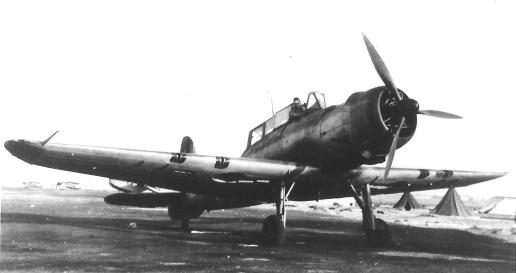
A rather nice view of a Skua showing well the four wing mounted machine guns. It was usual to tape these over with dull red coloured fabric tape to prevent water ingress that could freeze at altitude, hence the dark "squares" on the wing leading edge. In the background are some bell-tents, a couple of Swordfish aircraft and what looks like the nose of a Walrus amphibian peeking out from behind the Skua. Notice that the front of the propeller blades on this Skua have been painted black with yellow tips.

This is a wartime postcard, this time a half-tone reproduction. Note the square of gas detection paint on the wing, this would change colour if exposed to mustard or chlorine gas (everyone expected the Second World War to start with massive gas attacks). Note also the way the rear machine gun protrudes a little from the recess in which it would normally sit. Just aft of the wing you can see they have left the folding footstep in the "down" position. The small protrusion behind it is the tube down which a trailing wire antennae could be extended.
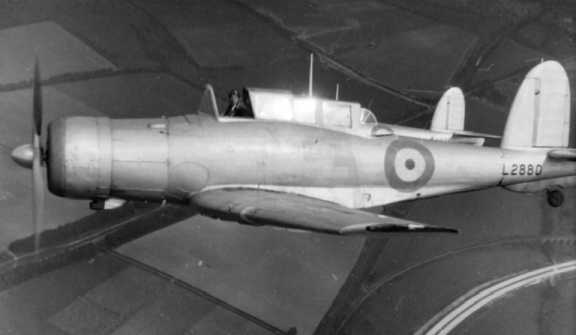
Great shot of two Skuas in flight, L2880 nearest. The white curve at the bottom right of the picture is the, then new, A33 Winchester bypass, the first stretch of dual-carriageway road built in open country in the UK. Landmarks pinpoint the position as being just South of Winchester. The Skuas were almost certainly flying from the nearby airfield at Worthy Down.
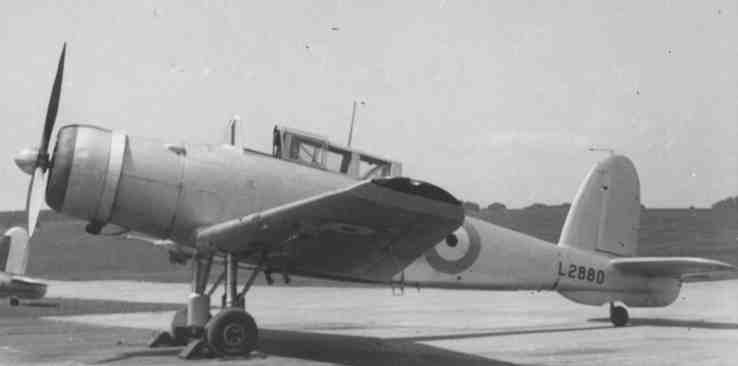
The same Skua (L2880) as shown flying in the picture above. In this photo you can clearly see coloured bands on the upturned wingtips, perhaps red nearest the tip and white inboard of the red.

If you look closely at the picture above you can see what looks like a panel line running from the rear gunner/observer/WT operators position to the tail. This was a dual cable run running outside the fuselage to operate an anti-spin parachute in the tail (one cable operated the parachute, the other cut it free once it had done its job). This was a late addition to the Skua's design and the reason it had to run outside was that the fuselage was designed to be water-tight to keep the aircraft afloat in the event of ditching. The designers took the easy way out when adding this modification! The cable-run takes a dog-leg so as not to obstruct the door to the dingy compartment on top of the rear fuselage. This is another aspect of the Skua's design not given in published plans of the aircraft. Skuas L2867 through to L2929 had landing lamps on both wings, the status of L2930 to L2932 is unknown, but certainly, from L2933 onwards Skuas only had a single lamp on the port wing. Hence these are early Skuas from the first batch. Note the oval inspection panel just forward and below the cockpit. A similar but much larger panel positioned lower down on the port side of the aircraft gave access to the forward fuel tank. Note the early "two-pronged" pitot tube on the starboard wing, only very early Skuas had this, later Skuas had a straight "single pronged" type.
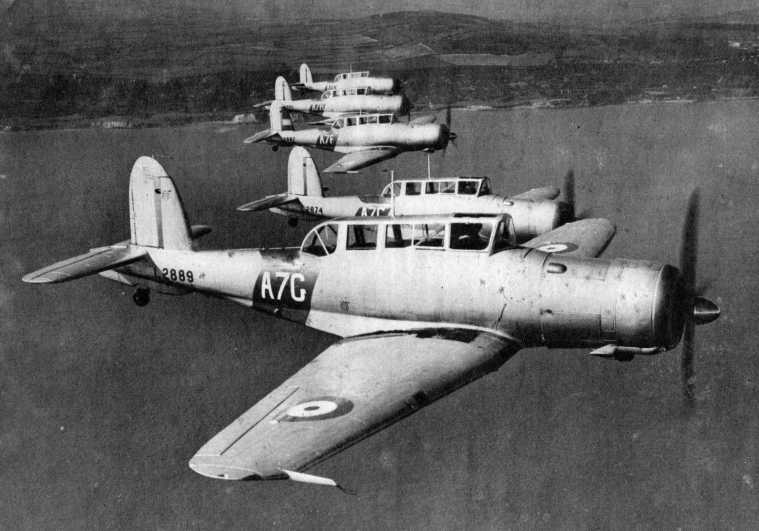
From the same "photo shoot" the picture above shows pre-war Skuas of 803 Sqdn sporting their silver finish.
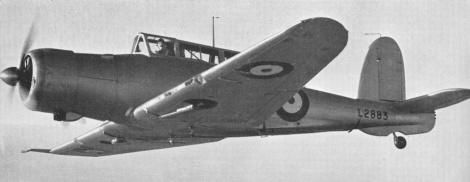
The picture above is from a Blackburn publicity brochure. It shows well the curved undercarriage doors and gives a hint of the way the underside of the wing swept up to mate with the large fillets which went back towards the tail..You can clearly see the way the fuselage seems to sit on top of the wing, with the broadest part of the fuselage being only slightly behind the wing's leading edge. The fuselage tapers towards the tail from this point, rather than from the wings trailing edge as in most aircraft of this layout. The recess in which the bomb sat was well aft, with the front of the recess being in line with the main spar. The large size of the Skua meant that even the big 500 lb bomb it carried in this recess looked tiny when fitted. The two projections under the fuselage are the rearmost pair of four fittings for the catapult trolley used to launch Royal Navy aircraft at this period.

The picture above shows the prototype Skua (called the Skua Mk I), note the shorter nose and wings that do nor have upswept tips. The engine of the prototype was a Bristol Mercury IX, which needed small bulges in the cowling over the engine rockers, something the sleeve-valve Perseus engine of the production Skua (Skua Mk II) did not require.

Another photo of the short-nosed first prototype K5178 carrying the large number "8" on the fuselage side applied for easy identification by the crowd at the Hendon Airshow of 1937.
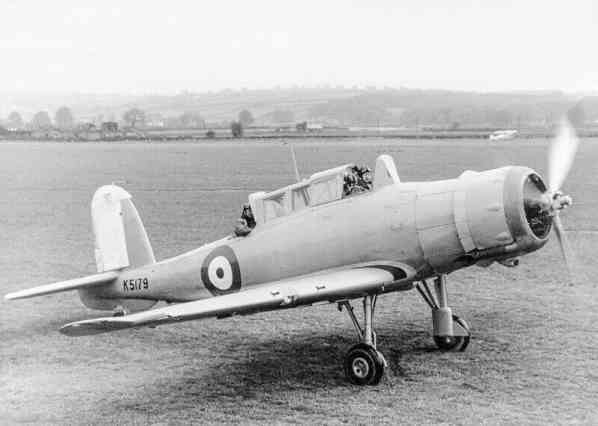
The second prototype, K5179 photographed at Blackburn's factory airfield at Brough next to the Humber river with the distinctive tree-lined ridge in the background. The second prototype still had a Mercury which required small bulges over the cylinder heads. The nose has been extended to improve aerodynamic stability. The way the guns protrude from the wings (because the anti-flash guards on the barrels had been left on) was not carried over to production Skuas. Likewise the way a portion of the fuselage surrounding the rear canopy rotated up with it to form a sort of windshield was also not a feature of production Skuas. The pilot looks to be Blackburn's test pilot Flt Lt Henry "Harry" Bailey who was tragically killed test-flying the Blackburn B20 flying boat.
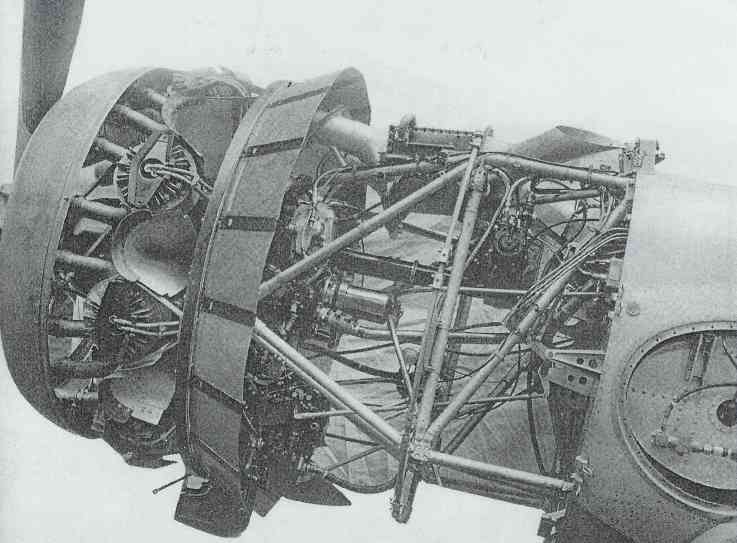
The engine installation on a production Skua. It shows that the elongated nose was mostly empty (wonder if a Merlin would have nicely filled that space?). Note the air baffles between each engine cylinder to concentrate the cooling airflow over the cylinder cooling fins.
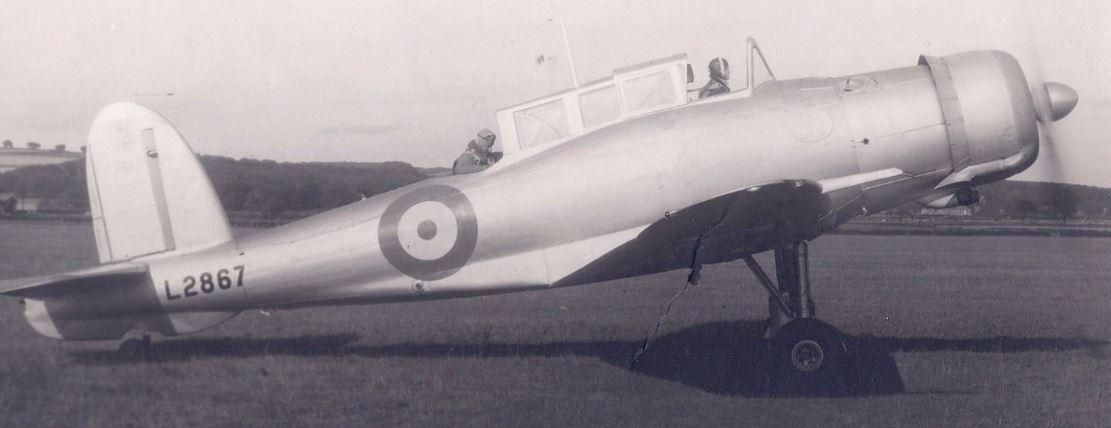
Production Skua L2867. A photo taken at Blackburn's factory airfield at Brough, again easily identified by the tree lined ridge on the horizon. In this side view you can see that the undercarriage stood vertical when on the ground , unlike most WW2 tailwheel aircraft. Also clearly seen is the slight curve to the top of the fuselage which put the pilot in an elevated position, giving an improved view over the nose, ideal for carrier landings. Apologies for the crease in the original photo.

Skuas ready for takeoff, the rear crewmen would often lock the rotating canopy covering forward and brace themselves at the rear for take-offs and landings.
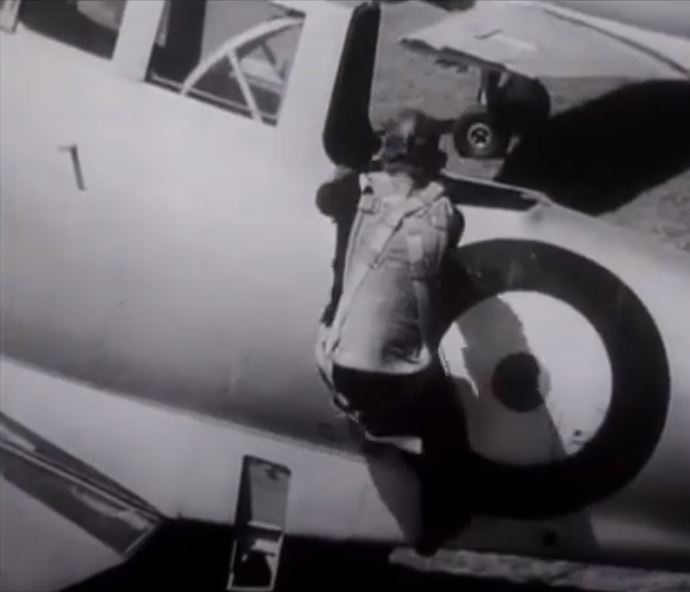
Getting into the rear of the Skua. Notice the short rod that stuck out horizontally from the side of the Skua fuselage. It seems to have simply served as a hand-hold.

Skuas on HMS Ark Royal, ranged for take-off. A still from the wartime feature-film "Ships with Wings".

Another still from "Ships with Wings". This Skua with folded wings has just been brought up on one of HMS Ark Royal's lifts from the hanger below.
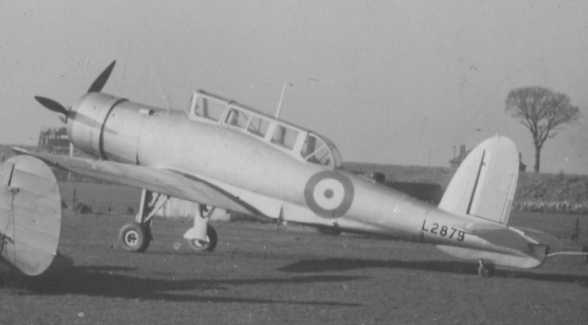
Skua L2879 with the tail of a Sea Gladiator on the right. Detail from a larger photograph. Certain details of the photo suggest it might have been taken on the Hatston airfield adjacent to Kirkwall on the Orkney Islands.
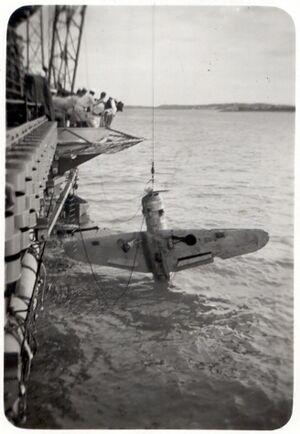
I am indebted to Mrs Rita Freeman for allowing me to show the dramatic picture above of the recovery of a Skua lost overboard in the harbour at Bermuda. It comes from her two brothers' collection of photos. Both of Rita's brothers served on HMS Illustrious. The ship's photographer (who normally worked processing reconnaissance photographs) sold copies of the photo to the ship's crew. See the full story of the Skua's watery dip on my page on "The Myth of Black Sunday".

This enlargement shows the Skua in greater detail. You can see the bomb recess is well aft , and only ends just above the waterline. Note that the inside of the port side wheel-well and flap housing are painted black - no doubt left over from the colour scheme the aircraft would have worn when shore-based, the underside of the port wing would have been painted black to aid identification by ground observers. You can also make out the vague outline of an overpainted roundel on the port wing. The small holes for ejecting the spent cartridges from the four wing mounted machine guns are clearly visible. The heavy staining on the starboard wing, near the fuselage, is due to the engine exhaust . This is L3012 with the code letter "K" on the fuselage sides, in front of the roundel. It had tall fin-flashes covering the static part of the rudder.
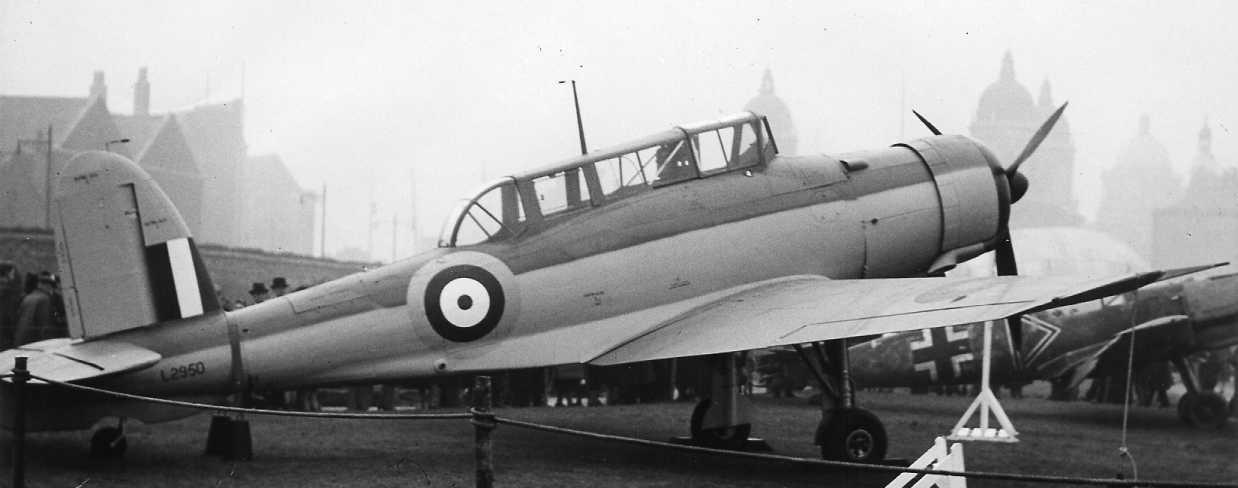
Skua L2950 on display next to a captured Bf109 in the city of Hull, not far from where the Skuas were manufactured. In this view you can clearly see the extra thickness of armoured glass on the front windscreen and the metal armour on the bottom of the side windscreens. These were added to Skuas in the second half of 1940.
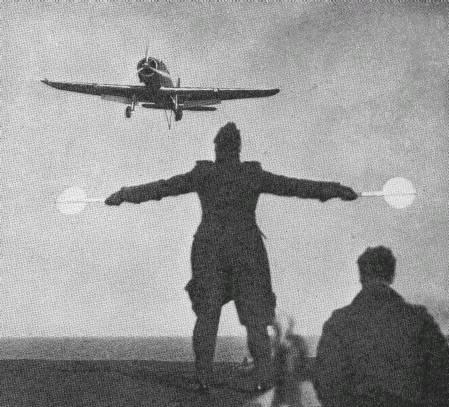
A Skua coming in to land on a carrier. You can see the "V" form of the arrestor hook. This hook could not be retracted again once released. You can also see the flaps which doubled as dive brakes. These flaps were of the "Zap" type : as they extended the front edge of the flap was drawn back, ending up in the middle of the recess in which the retracted flap sat. The advantage of this type of flap was that the centre of gravity of the aircraft was not affected by their operation, hence there was no need to re-trim.
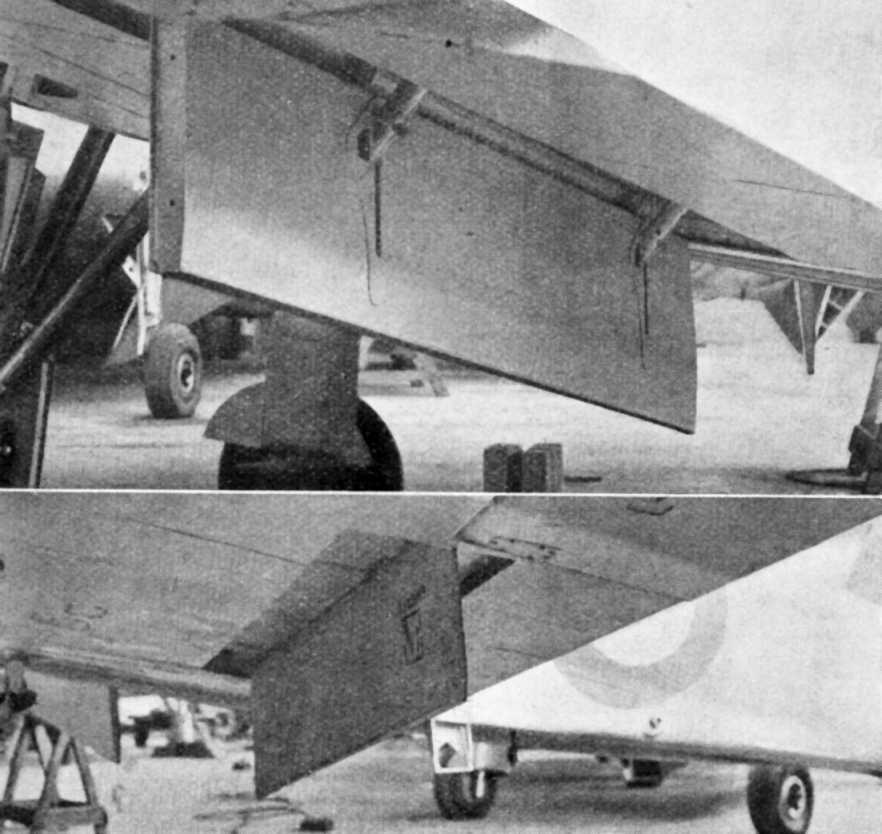
The Skua's "Zap" Flaps

Skua taking off from aircraft carrier.

Loading a belt of .303 ammunition for one of the Skua's four wing mounted Browning machine-guns. Although the Skua had only four machine guns compared to the eight guns carried by both the Spitfire and Hurricane, each of the Skuas gun magazines could carry almost twice the number of rounds. This meant the Skua pilot had nearly twice the firing time of the Spitfire or Hurricane.
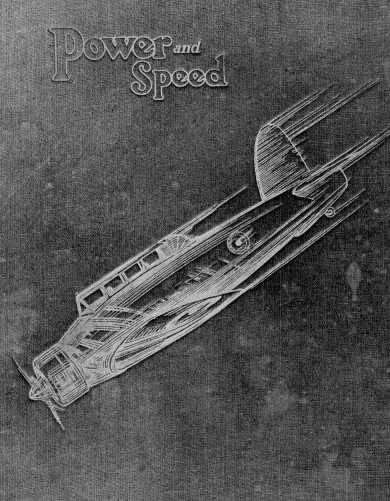
In the late 30's the Blackburn Skua was the very epitome of Speed and Power (embossed jacket for a 1939 book on the various uses of the internal combustion engine).
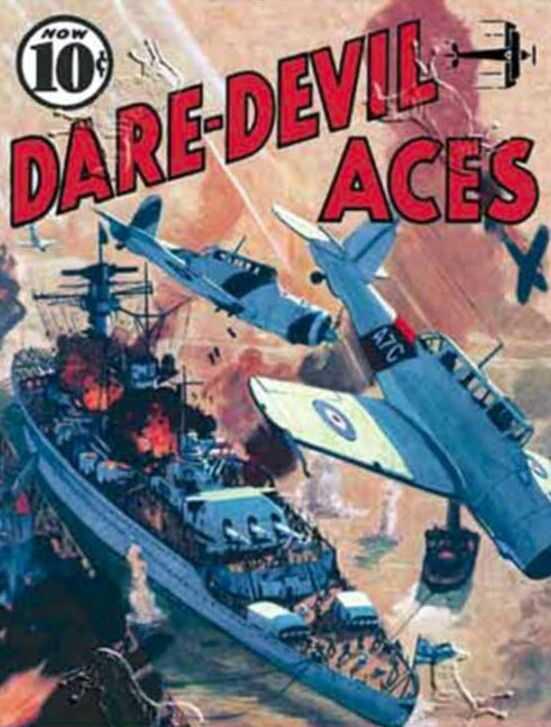
This splendid cover to an American comic book was clearly meant to show the attack on the Königsberg. The artist has used the limited photos of Skuas available at the time. So the nearest Skua is in pre-war markings (see photo near the top of this page, clearly the photo the artist copied) and the Skua behind it has the black stripes of a target tug, (actual target tug markings were black on yellow "tiger stripes"). The ship is not the Königsberg but is copied from pre-war photos of the pocket battleship Graf Spee. I do not think the little 24lb bombs tumbling from the second Skua would have done much harm to a pocket battleship! For my own attempt at a painting of the attack on the Königsberg CLICK HERE.
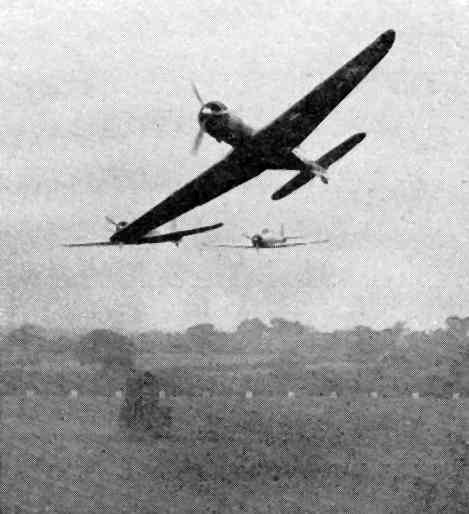
When Birmingham's new airport at Elmdon was opened in 1939 a formation of Skuas put on a display including a low-level mock attack on a dummy wooden submarine conning tower.
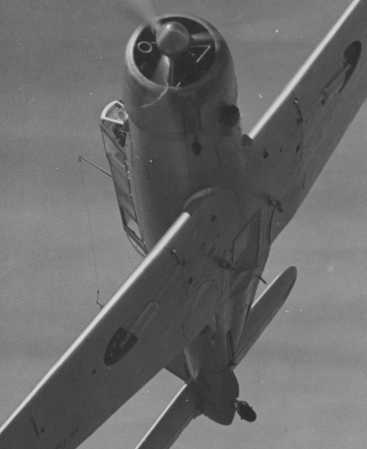
Skua in flight.
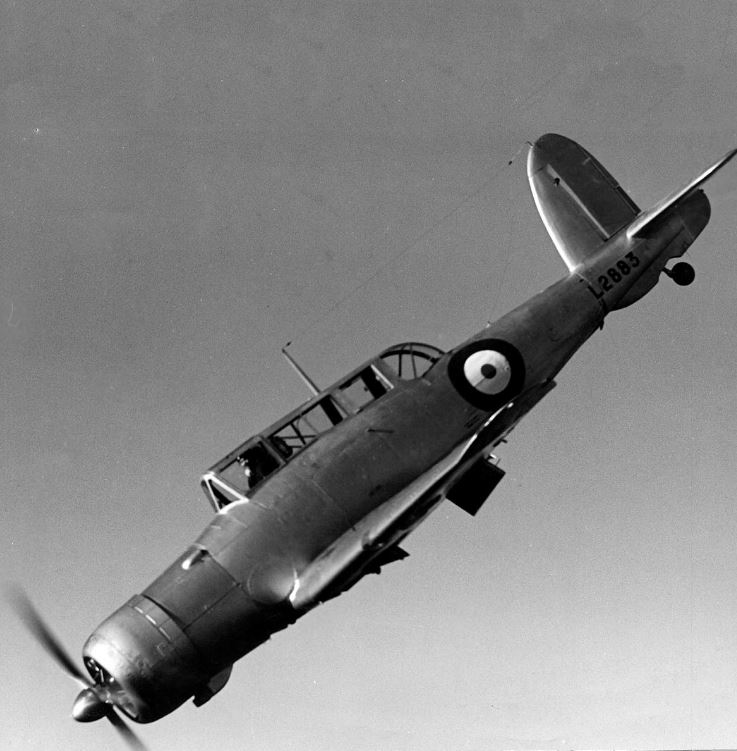
Skua L2883 in a dive.
There are lots more detailed photos on the follow-on webpage on modelling the Blackburn Skua.
Also more detailed photos of the wrecked Skua in the FAA Museum.
This page is devoted to pictures and images of the Skua. It is a follow on to the description of Skua found on <this link>.

A rather nice view of a Skua showing well the four wing mounted machine guns. It was usual to tape these over with dull red coloured fabric tape to prevent water ingress that could freeze at altitude, hence the dark "squares" on the wing leading edge. In the background are some bell-tents, a couple of Swordfish aircraft and what looks like the nose of a Walrus amphibian peeking out from behind the Skua. Notice that the front of the propeller blades on this Skua have been painted black with yellow tips.

This is a wartime postcard, this time a half-tone reproduction. Note the square of gas detection paint on the wing, this would change colour if exposed to mustard or chlorine gas (everyone expected the Second World War to start with massive gas attacks). Note also the way the rear machine gun protrudes a little from the recess in which it would normally sit. Just aft of the wing you can see they have left the folding footstep in the "down" position. The small protrusion behind it is the tube down which a trailing wire antennae could be extended.

Great shot of two Skuas in flight, L2880 nearest. The white curve at the bottom right of the picture is the, then new, A33 Winchester bypass, the first stretch of dual-carriageway road built in open country in the UK. Landmarks pinpoint the position as being just South of Winchester. The Skuas were almost certainly flying from the nearby airfield at Worthy Down.

The same Skua (L2880) as shown flying in the picture above. In this photo you can clearly see coloured bands on the upturned wingtips, perhaps red nearest the tip and white inboard of the red.

If you look closely at the picture above you can see what looks like a panel line running from the rear gunner/observer/WT operators position to the tail. This was a dual cable run running outside the fuselage to operate an anti-spin parachute in the tail (one cable operated the parachute, the other cut it free once it had done its job). This was a late addition to the Skua's design and the reason it had to run outside was that the fuselage was designed to be water-tight to keep the aircraft afloat in the event of ditching. The designers took the easy way out when adding this modification! The cable-run takes a dog-leg so as not to obstruct the door to the dingy compartment on top of the rear fuselage. This is another aspect of the Skua's design not given in published plans of the aircraft. Skuas L2867 through to L2929 had landing lamps on both wings, the status of L2930 to L2932 is unknown, but certainly, from L2933 onwards Skuas only had a single lamp on the port wing. Hence these are early Skuas from the first batch. Note the oval inspection panel just forward and below the cockpit. A similar but much larger panel positioned lower down on the port side of the aircraft gave access to the forward fuel tank. Note the early "two-pronged" pitot tube on the starboard wing, only very early Skuas had this, later Skuas had a straight "single pronged" type.

From the same "photo shoot" the picture above shows pre-war Skuas of 803 Sqdn sporting their silver finish.

The picture above is from a Blackburn publicity brochure. It shows well the curved undercarriage doors and gives a hint of the way the underside of the wing swept up to mate with the large fillets which went back towards the tail..You can clearly see the way the fuselage seems to sit on top of the wing, with the broadest part of the fuselage being only slightly behind the wing's leading edge. The fuselage tapers towards the tail from this point, rather than from the wings trailing edge as in most aircraft of this layout. The recess in which the bomb sat was well aft, with the front of the recess being in line with the main spar. The large size of the Skua meant that even the big 500 lb bomb it carried in this recess looked tiny when fitted. The two projections under the fuselage are the rearmost pair of four fittings for the catapult trolley used to launch Royal Navy aircraft at this period.

The picture above shows the prototype Skua (called the Skua Mk I), note the shorter nose and wings that do nor have upswept tips. The engine of the prototype was a Bristol Mercury IX, which needed small bulges in the cowling over the engine rockers, something the sleeve-valve Perseus engine of the production Skua (Skua Mk II) did not require.

Another photo of the short-nosed first prototype K5178 carrying the large number "8" on the fuselage side applied for easy identification by the crowd at the Hendon Airshow of 1937.

The second prototype, K5179 photographed at Blackburn's factory airfield at Brough next to the Humber river with the distinctive tree-lined ridge in the background. The second prototype still had a Mercury which required small bulges over the cylinder heads. The nose has been extended to improve aerodynamic stability. The way the guns protrude from the wings (because the anti-flash guards on the barrels had been left on) was not carried over to production Skuas. Likewise the way a portion of the fuselage surrounding the rear canopy rotated up with it to form a sort of windshield was also not a feature of production Skuas. The pilot looks to be Blackburn's test pilot Flt Lt Henry "Harry" Bailey who was tragically killed test-flying the Blackburn B20 flying boat.

The engine installation on a production Skua. It shows that the elongated nose was mostly empty (wonder if a Merlin would have nicely filled that space?). Note the air baffles between each engine cylinder to concentrate the cooling airflow over the cylinder cooling fins.

Production Skua L2867. A photo taken at Blackburn's factory airfield at Brough, again easily identified by the tree lined ridge on the horizon. In this side view you can see that the undercarriage stood vertical when on the ground , unlike most WW2 tailwheel aircraft. Also clearly seen is the slight curve to the top of the fuselage which put the pilot in an elevated position, giving an improved view over the nose, ideal for carrier landings. Apologies for the crease in the original photo.

Skuas ready for takeoff, the rear crewmen would often lock the rotating canopy covering forward and brace themselves at the rear for take-offs and landings.

Getting into the rear of the Skua. Notice the short rod that stuck out horizontally from the side of the Skua fuselage. It seems to have simply served as a hand-hold.

Skuas on HMS Ark Royal, ranged for take-off. A still from the wartime feature-film "Ships with Wings".

Another still from "Ships with Wings". This Skua with folded wings has just been brought up on one of HMS Ark Royal's lifts from the hanger below.

Skua L2879 with the tail of a Sea Gladiator on the right. Detail from a larger photograph. Certain details of the photo suggest it might have been taken on the Hatston airfield adjacent to Kirkwall on the Orkney Islands.

I am indebted to Mrs Rita Freeman for allowing me to show the dramatic picture above of the recovery of a Skua lost overboard in the harbour at Bermuda. It comes from her two brothers' collection of photos. Both of Rita's brothers served on HMS Illustrious. The ship's photographer (who normally worked processing reconnaissance photographs) sold copies of the photo to the ship's crew. See the full story of the Skua's watery dip on my page on "The Myth of Black Sunday".

This enlargement shows the Skua in greater detail. You can see the bomb recess is well aft , and only ends just above the waterline. Note that the inside of the port side wheel-well and flap housing are painted black - no doubt left over from the colour scheme the aircraft would have worn when shore-based, the underside of the port wing would have been painted black to aid identification by ground observers. You can also make out the vague outline of an overpainted roundel on the port wing. The small holes for ejecting the spent cartridges from the four wing mounted machine guns are clearly visible. The heavy staining on the starboard wing, near the fuselage, is due to the engine exhaust . This is L3012 with the code letter "K" on the fuselage sides, in front of the roundel. It had tall fin-flashes covering the static part of the rudder.

Skua L2950 on display next to a captured Bf109 in the city of Hull, not far from where the Skuas were manufactured. In this view you can clearly see the extra thickness of armoured glass on the front windscreen and the metal armour on the bottom of the side windscreens. These were added to Skuas in the second half of 1940.

A Skua coming in to land on a carrier. You can see the "V" form of the arrestor hook. This hook could not be retracted again once released. You can also see the flaps which doubled as dive brakes. These flaps were of the "Zap" type : as they extended the front edge of the flap was drawn back, ending up in the middle of the recess in which the retracted flap sat. The advantage of this type of flap was that the centre of gravity of the aircraft was not affected by their operation, hence there was no need to re-trim.

The Skua's "Zap" Flaps

Skua taking off from aircraft carrier.

Loading a belt of .303 ammunition for one of the Skua's four wing mounted Browning machine-guns. Although the Skua had only four machine guns compared to the eight guns carried by both the Spitfire and Hurricane, each of the Skuas gun magazines could carry almost twice the number of rounds. This meant the Skua pilot had nearly twice the firing time of the Spitfire or Hurricane.

In the late 30's the Blackburn Skua was the very epitome of Speed and Power (embossed jacket for a 1939 book on the various uses of the internal combustion engine).

This splendid cover to an American comic book was clearly meant to show the attack on the Königsberg. The artist has used the limited photos of Skuas available at the time. So the nearest Skua is in pre-war markings (see photo near the top of this page, clearly the photo the artist copied) and the Skua behind it has the black stripes of a target tug, (actual target tug markings were black on yellow "tiger stripes"). The ship is not the Königsberg but is copied from pre-war photos of the pocket battleship Graf Spee. I do not think the little 24lb bombs tumbling from the second Skua would have done much harm to a pocket battleship! For my own attempt at a painting of the attack on the Königsberg CLICK HERE.

When Birmingham's new airport at Elmdon was opened in 1939 a formation of Skuas put on a display including a low-level mock attack on a dummy wooden submarine conning tower.

Skua in flight.

Skua L2883 in a dive.
There are lots more detailed photos on the follow-on webpage on modelling the Blackburn Skua.
Also more detailed photos of the wrecked Skua in the FAA Museum.
